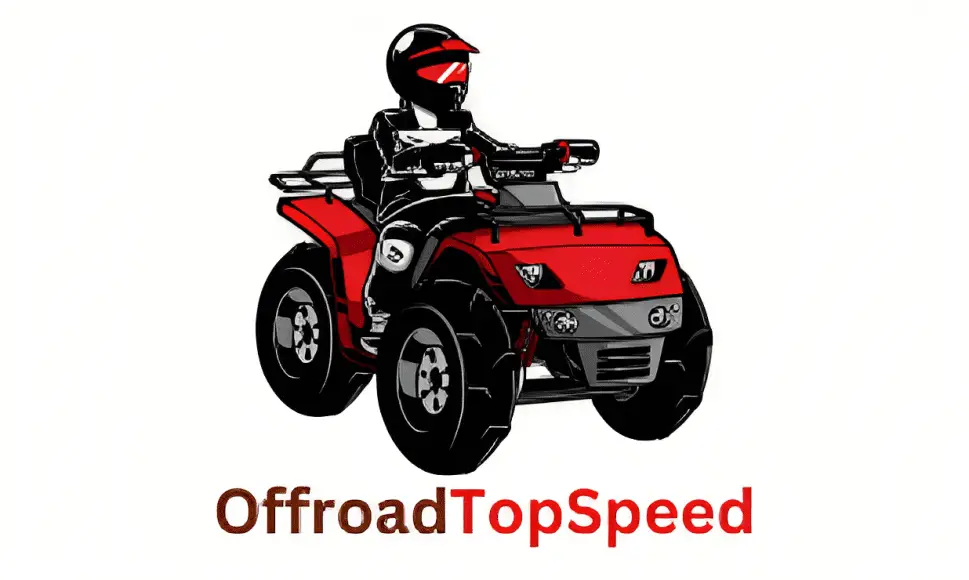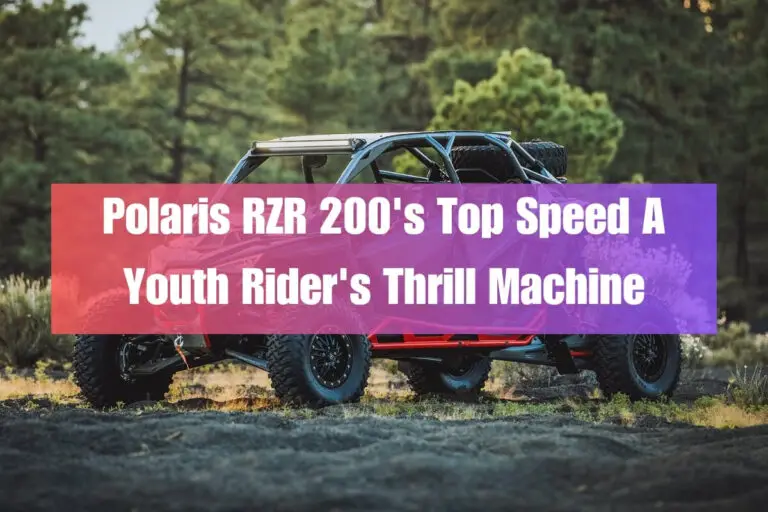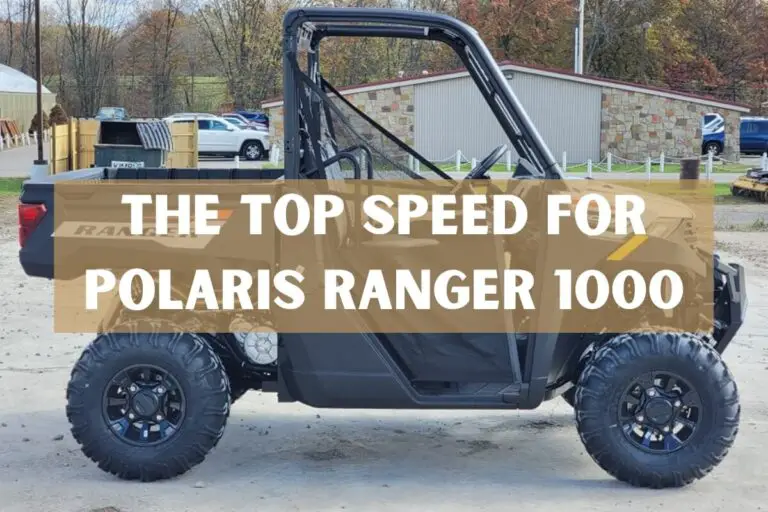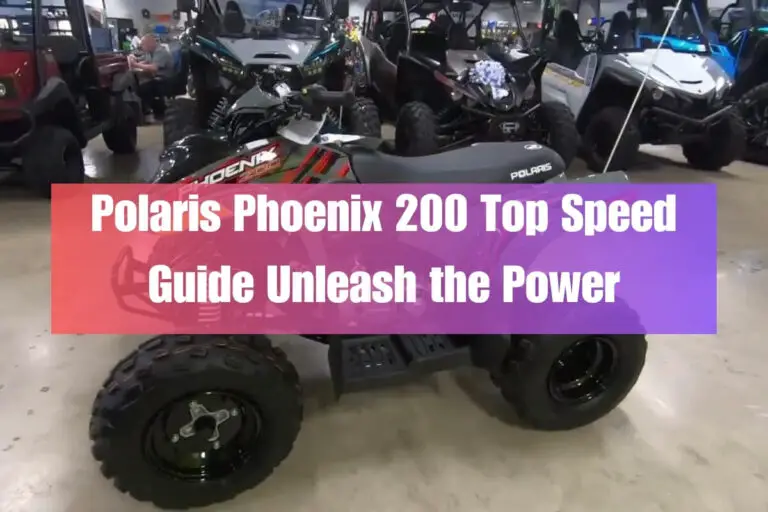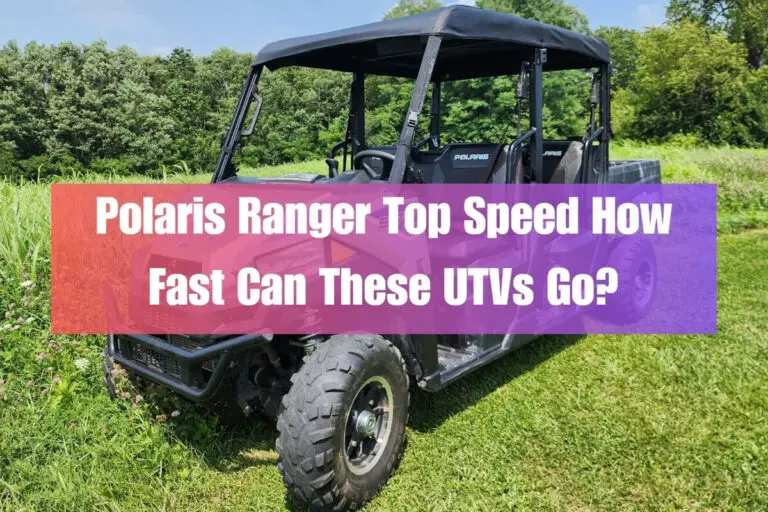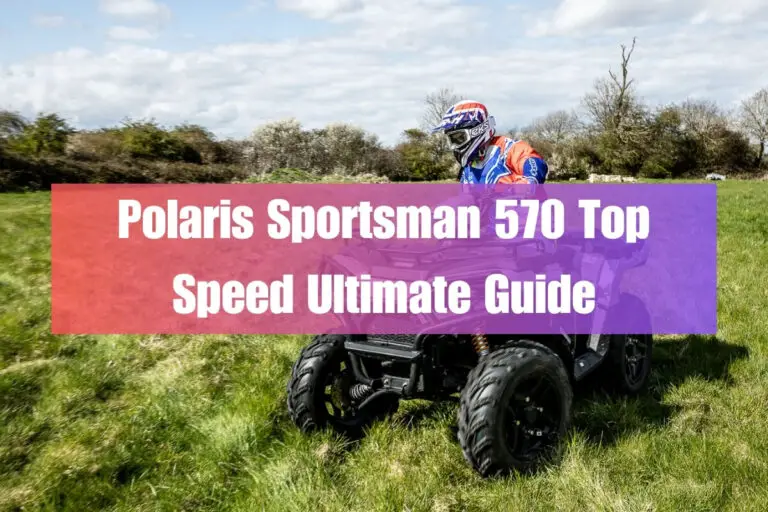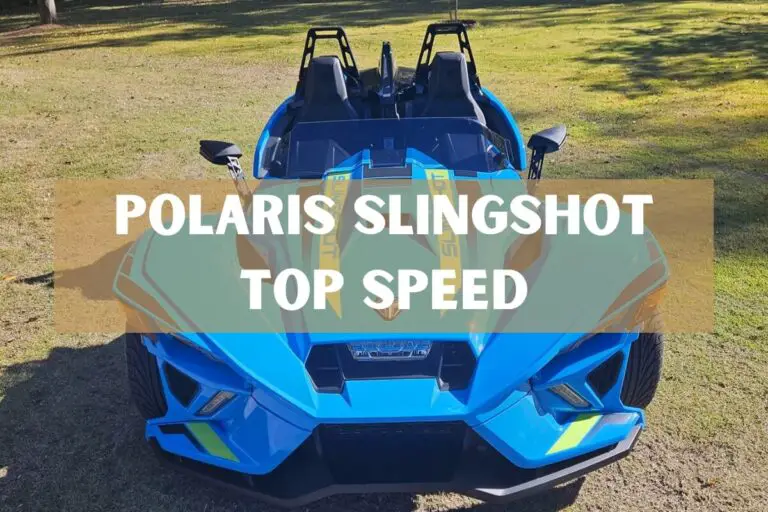Polaris RZR Top Speed: How Fast Can These Beasts Go?

If you’re a thrill-seeker who lives for the adrenaline rush of high-speed off-road driving, you’ve probably wondered – just how fast can a Polaris RZR really go? The RZR line from Polaris is renowned for pushing the limits of side-by-side (SxS) performance, with the top models boasting jaw-dropping acceleration and blistering top speeds.
This guide looks at how fast different Polaris RZR models can go. It covers what factors impact their top speeds. The guide shares owner experiences with RZR top speeds. It compares RZR top speeds to other vehicles. The guide discusses if higher top speeds are important for RZRs.
RZR Model Overview
Before we get to the speed numbers, let’s quickly go over the Polaris RZR lineup. The RZR family has grown extensively since the original 800 model launched back in 2008. It now encompasses a wide range of vehicles suited for different riding styles and budgets.
The current flagship is the outrageous Polaris RZR Pro R, unveiled in 2021. Powered by a monstrous 2.0L 225hp naturally-aspirated engine, it’s officially the most powerful production UTV (utility task vehicle) ever made. The base Pro R starts at a staggering $31,999 MSRP.
Other noteworthy models include the turbo-powered RZR Turbo R ($27,799), the capable trail models like the RZR Trail ($15,999) and Trail S ($17,999), and the versatile RZR XP Series starting at $20,999.
Blistering Performance
So just how fast are these rocket-powered side-by-sides? The numbers are mind-boggling:
Polaris RZR Pro R Top Speed: 90 mph Polaris RZR Turbo R Top Speed: Up to 94 mph Other RZR Models: 80-85 mph
0-60 mph times are equally staggering, with the range-topping Pro R rocketing to 60 mph from a standstill in just 5.11 seconds! The Turbo R isn’t far behind at around 6 seconds flat.
For a more visual perspective, check out this specs table comparing the top RZR performers:
| Model | Engine | HP | 0-60 mph | Top Speed | Price |
|---|---|---|---|---|---|
| RZR Pro R | 2.0L NA | 225 | 5.11 sec | 90 mph | $31,999 |
| RZR Turbo R | 2.0L Turbo | 181 | ~6 sec | 94 mph | $27,799 |
| RZR XP Turbo | 1.0L Turbo | 168 | ~6 sec | 85 mph | $24,399 |
| RZR XP 1000 | 1.0L NA | 110 | ~8 sec | 80 mph | $20,999 |
Suffice to say, the RZR models – especially the flagship Pro R – boast extraordinary straight-line performance that will pin you back in the seat and put a massive grin on your face.
What Determines a RZR’s Top Speed?
While engine output is the prime determinant of a vehicle’s top speed potential, several other factors come into play:
Engine Size and Power: Bigger, more powerful engines can propel a vehicle to higher top speeds by overcoming air resistance and drivetrain losses more easily. The Pro R’s 225hp 2.0L motor is a prime example.
Drivetrain and Gearing: The transmission gear ratios determine how engine power is translated to the wheels. Closer gear ratios allow higher top speeds.
Tire Size and Type: Larger diameter tires have a higher theoretical top speed ceiling, while aggressive tread patterns increase rolling resistance.
Weight and Aerodynamics: Heavier vehicles require more power to overcome inertia and air resistance. Sleek body designs help cut through the air better.
Experienced tuners can extract higher top speeds through a combination of engine modifications, transmission gear swaps, tire upgrades, and weight reduction measures.
Owner Reviews and Experiences
What do real Polaris RZR owners have to say about their vehicles’ bowel-loosening top speed abilities? The experiences are quite polarizing:
On the positive side, owners frequently gush about the sheer exhilaration of pushing their RZRs to the limit:
“My Turbo R has touched an indicated 94 mph on the GPS…what a rush! I’ve never experienced acceleration and power like that outside of a high-end sports car.”
“Took the new Pro R out to the dry lake bed and went full send. That thing is a rocket ship from 0-60, and the top speed is completely usable and stable.”
However, not everyone is chasing dragstrip performance numbers on their RZR:
“90 mph?! Why would anyone want to go that fast on trails and risk crashing? My XP 1000 tops out at 75 mph which is plenty for me.”
“Sure the Pro R is crazy fast, but it’s too much money and overkill for 90% of riders. Give me a more affordable model with reasonable power.”
Many claim that with extensive engine/drivetrain tuning, it’s possible to push even stock Polaris RZR models well past their factory-rated top speeds.
How the RZR Stacks Up Against the Competition
In the world of high-performance side-by-sides, how does the Polaris RZR family’s blistering speed fare against its key rivals?
The closest competitor is undoubtedly the Can-Am Maverick X3 lineup from Polaris’ arch nemesis, Can-Am. The range-topping Can-Am Maverick X3 X RS Turbo RR with its 195hp turbocharged three-cylinder can hit 92 mph and match the Polaris RZR in straight line speed. However, the Can-Am is lighter and has a slight advantage in acceleration.
On the lower end, models like the Arctic Cat Wildcat XX and Honda Talon R max out at 80-85 mph – respectable but no match for the flagship RZR’s in a straight drag race.
Modifications to Increase Top Speed
For many RZR owners, even the mind-bending factory performance isn’t enough – they crave morespeed at all costs through aftermarket modifications. Some of the most popular RZR top speed mods include:
Forced Induction: Strapping on an aftermarket turbo or supercharger system can boost the RZR’s power output dramatically. Reputable kits from brands like Driveline FTW the potential to push the RZR Pro R engine beyond 300hp!
Exhaust Upgrades: Replacing the restrictive factory exhaust with a free-flowing aftermarket system helps the engine breathe better for increased horsepower.
Weight Reduction: Ditching unnecessary weight through lighter wheels/tires, removing interior trim, and installing a high-clearance thin-shell body can reduce rotational mass and improve acceleration.
Aerodynamic Improvements: While unlikely to yield dramatic gains, adding aerodynamic bodywork and underbody diffusers can help the RZR slip through the air more efficiently.
Of course, extensive modifications come with their own set of drawbacks like increased mechanical stress, potential warranty issues, and legal restrictions on public lands.
Pros and Cons of High Top Speeds
Is having a side-by-side with a ridiculously high top speed actually a good thing? Like most things in life, it’s a double-edged sword:
Pros:
- Incredible acceleration and passing power
- Ability to conquer steep dunes and hills with momentum
- Endless bragging rights
Cons:
- Potential stability and safety concerns at very high speeds
- Accelerated component wear and tear from the added stresses
- Many areas and trails legally limit or prohibit high-speed operation
Balancing mind-blowing speed with reasonable responsibility is key for getting the most enjoyment out of your souped-up SxS.
Alternatives to Consider
If the prospect of a side-by-side shattering the 90 mph barrier seems excessive (or just too darn expensive), there are some compelling alternatives to weigh:
Lower Cost High-Performance: While not quite reaching the stratospheric top speeds of the range-topping Polaris RZR models, more affordable side-by-sides like the Can-Am Maverick Trail and Yamaha YXZ1000R can still satisfy your need for speed at a lower price point.
The Maverick Trail is a downsized 50″ wide version focused on nimble trail performance, but even the base 75hp model is no slouch, with a claimed top speed of 60 mph. The fire-breathing Maverick Trail 1000cc turbo cranks out 121hp and bumps the top speed up to a very respectable 85 mph.
The Yamaha YXZ1000R side-by-side takes a more pure sport approach, with over 110 hp from its inline triple engine and a top speed around 80 mph. It’s a hoot to thrash around tight tracks and trails.
Affordable Trail Rigs: If maximum velocity isn’t your top priority, Polaris and its rivals offer more affordable trail-focused models that are still plenty capable in the go-fast department.
The Polaris RZR Trail and Trail S models start at $15,999 with a 75hp engine, decent 60+ mph top speeds, and genuine off-road prowess in tighter confines.
Similarly, Honda’s Talon line provides a budget-friendly trail option, with the base 1000R clocking in at around 70 mph flat-out despite its relatively modest 104hp power output.
Who Should (and Shouldn’t) Buy a High-Speed RZR?
With all this talk of blistering straight-line performance, the question remains – who is best suited for a maximized-for-speed side-by-side like the Polaris RZR Pro R or Turbo R? And who might be better off with a tamer, more affordable option?
The High-Speed RZR is Perfect For:
- Thrill-seekers and adrenaline junkies who crave mind-bending acceleration and top speed
- Competitive racers who need every last ounce of performance
- Open desert runners where you can safely explore the upper realms of a vehicle’s velocity
A Slower Trail Model May Be Wiser For:
- Casual recreationalists who don’t need excessive speed
- Forest trail explorers where tight confines limit maximum speeds anyway
- Budget-minded buyers put off by the high cost of range-topping performance models
Don’t get me wrong – even a “slow” 70 mph side-by-side is an absolute riot to pitch down a twisty fire road. But if you really want that hypercar kick-in-the-pants acceleration rush, you’ll need to pony up for a top-dog RZR.
Troubleshooting Common Issues
All that speed and power inevitably invites some unique challenges and pitfalls that RZR owners need to watch out for:
Overheating: Slogging through deep powder or blasting across a dry lakebed at wide-open throttle is a surefire recipe for heat soak. Prudent gearing, good cooling system maintenance, and strategic cool-down periods are musts. An auxiliary cooling package can help in the most extreme cases.
Premature Tire Wear: Sticky race-compound tires may hook up great for dragstrip-esque launches, but they’ll fry themselves in no time on abrasive surfaces like rock faces. Having a dedicated off-road tire rotation is wise.
Suspension Topping Out: Even the most high-zoot long-travel suspension systems have their limits when you’re sending your side-by-side into orbit at triple-digit velocities. Proper shock tuning from the pros can tame the jarring impacts.
Driveline Grenades: Let’s be real – stuffing upwards of 200 hp through lightweight driveline components designed for 50-80 hp UTVs puts immense strain on U-joints, axles and differentials. Upgrading these weakpoints is insurance against catasrophic (and costly) failures.
Frequently Asked Questions
Still have some burning questions about how fast Polaris RZRs can truly go? Let’s cover some of the most common FAQs:
How do I increase my RZR’s top speed?
Common mods include exhaust, intake, tuning for more power, taller gearing, lighter wheels/tires, and aerodynamic aids. But be wary of stressing components too far.
What’s the fastest Polaris RZR ever made?
The 2021+ Polaris Pro R, with its 225hp 2.0L engine and claimed 90 mph top speed.
How do RZR top speeds compare to SxS race vehicles?
Purpose-built off-road race machines like the Polaris RZR Pro XP Unlimited can exceed 120 mph in ideal conditions. But these are extremely specialized vehicles.
What is top speed affected by on a side-by-side?
Primarily engine output, vehicle weight, gearing/drivetrain, tires, and aerodynamics. More power and taller gearing helps, while excess weight/drag hurts top speed.
Is it worth getting a super high-speed RZR?
That depends on your priorities – if you’ll truly exploit the performance regularly, it can be exhilarating. But for most riders, a balanced mid-range model is wiser.
Final Thoughts
There’s no denying the visceral thrill and eye-widening statistics of vehicles like the Polaris RZR Pro R. Surpassing 90 mph in a relatively lightweight side-by-side borders on insane…yet Polaris made it a reality with brute horsepower and remarkable chassis engineering.
But does the average rider really need that level of speed capability? Probably not – even 70-80 mph is far more than enough velocity for most trail sessions and potentially quite dangerous to attempt sustained high-speed running.
My advice? Unless you’re a hardcore speed freak who will legitimately take advantage of triple-digit top speeds regularly, you’re likely better off saving coin and opting for a lower-trim but still extremely potent RZR model. A Turbo S or XP Pro can utterly demolish 95% of riders’ performance needs at a much lower buy-in cost.
That said, I can’t help but admire Polaris’ ambition in creating an ultra-high velocity side-by-side simply because they could. The envelope-pushing Polaris RZR lineup continues redefining what’s possible in the world of off-road performance. As gearheads and speed junkies, we’re all better off for these beasts existing to push the limits.
So while outrageous speed may not be a necessity, the fact that it’s even attainable in a productionside-by-side is something to appreciate and respect. Now if you’ll excuse me, I have a date with the quarter mile…
